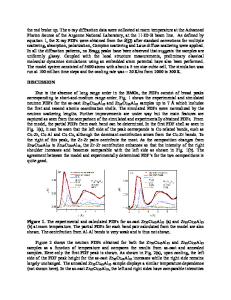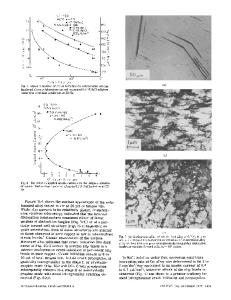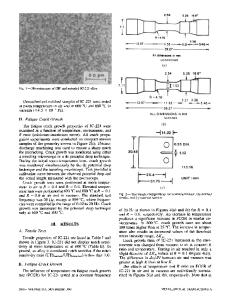Effects of Glass-Forming Metallic Film on the Fatigue Behavior of C-2000 Ni-Based Alloy
- PDF / 1,051,758 Bytes
- 6 Pages / 612 x 792 pts (letter) Page_size
- 2 Downloads / 373 Views
0903-Z14-13.1
Effects of Glass-Forming Metallic Film on the Fatigue Behavior of C-2000 Ni-Based Alloy F. X. Liu1, C. L. Chiang1,2, J. P. Chu2, Y. F. Gao1, and P. K. Liaw1 Dept. Materials Science & Engrg., The University of Tennessee, Knoxville, TN 37996, U.S.A. 2 Institute of Materials Engineering, National Taiwan Ocean University, Keelung 202, Taiwan. 1
ABSTRACT Glass-forming Zr47Cu31Al13Ni9 (in atomic percent) films of various thicknesses were deposited on the C-2000 Ni-based alloy substrate by magnetron sputtering. Four-point-bending fatigue tests were conducted on the above system with the coated surface on the tensile side. It has been found that both fatigue life and fatigue-endurance limit can be considerably improved, while the degree of fatigue resistance enhancement depends on the maximum applied stress and the film thickness. Mechanisms of fatigue-resistance enhancements of the coated Ni-based alloy are discussed from the following aspects: reduction of surface roughness by the thin-film coating, good adhesion between thin film and substrate, development of residual compressive stress, and excellent ductility of glass-forming thin film (which would be otherwise brittle in bulk form). Of particular interest, we examine the interaction of substrate slip bands and the thin film ductile property, which would delay fatigue crack initiation process and thus extend the fatigue life. INTRODUCTION Bulk metallic glass (BMG) materials show enhanced plasticity behavior when the propagation of shear bands is confined in order to prevent catastrophic failure, which thus motivates us to use a glass-forming metallic thin film as a coating material with anticipated high ductile properties. [1-6]. Thin films can be deposited on substrates as potential candidate materials for Micro-Electro-Mechanical Systems (MEMS) devices, owning to their excellent mechanical properties and high corrosion resistance [3]. The application of Zr75Cu19Al6 and Pd76Cu7Si17 glass-forming thin films as conical spring and micro actuator has been demonstrated [4-5]. By synthesizing amorphous layers on crystalline substrates, the surface performances could be improved due to high micro-hardness, low friction coefficient, and improved wear resistance [6]. Through thermal annealing of the as-sputtered Zr47Cu31Al13Ni9 film in the supercooled liquid region (∆T), the control of the nanocrystallization and amorphization could be realized [2]. Recently, people have discovered that the mechanical properties, especially the ductility of metallic glasses in the form of thin films, can be enhanced due to the geometry-confinement effects [7-10]. In view of their high strength, improved ductility, excellent wear and corrosion resistances, and good surface finishes, glass-forming films are anticipated to be ideal coating materials to improve the fatigue resistance behavior of structural materials. EXPERIMENTAL DETAILS The HAYNES C-2000® Ni-based superalloy was used as the substrate material. The superalloy samples with geometry of 3 × 3 × 25 mm3 were ground with
Data Loading...











